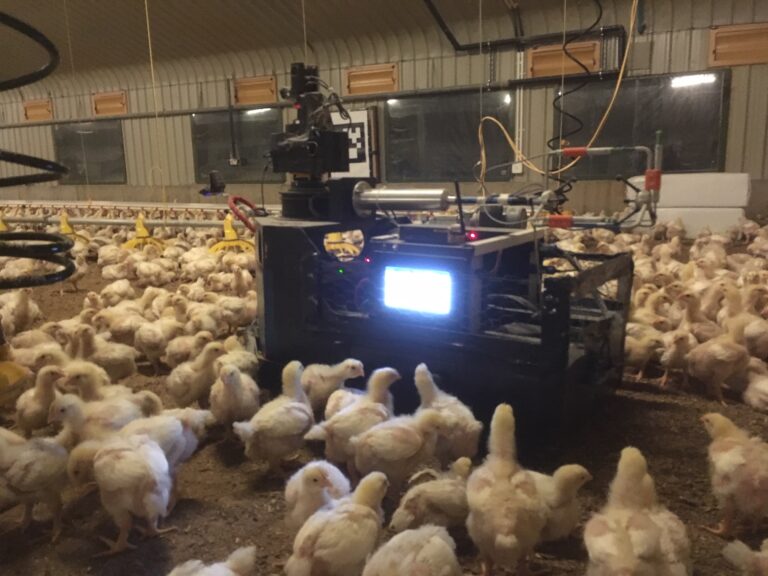Feed conversion ratios improved 8% in a trial that placed a roving robot in a 44,000-broiler shed. That was one of the surprising findings of a joint project between the Royal Veterinary College, Ross Robotics, Harper Adams University and Applied Poultry.
The researchers now believe the Robochick robot could become a commercial success, with many applications in poultry farming, but want to repeat the trial over seven to 10 flocks first to ensure the finding was no coincidence.
Theo Demmers, lead researcher from the Royal Veterinary College, said the initial aim was to use the modular robot to collect environmental data via sensors in order to better manage temperature and humidity in poultry houses.
But unexpectedly in the shed where the robot was operating there was a positive effect on FCR of 8%. “We were surprised, because you would have thought the birds would use more energy moving out of the way of the robot,” says Demmers. “But our hypothesis is the robot disrupts the dominance and hierarchy among the birds around the feeders and drinkers and allows the birds that would normally be excluded to access more feed and water, creating a more uniform flock.”
Initial trialling of various designs for the robot running once a week for half a morning led to a basic design; a pointy nose in order to move the birds sideways. The trial wasn’t an immediate success, says Demmers. “We were scared it wouldn’t work because the birds left a large empty space behind the robot of up to 20 metres. It was clear the birds were scared of it.”
Before trialling the robot on a 44,000-bird unit, the researchers first trialled it on a small poultry house measuring 8 X 15 metres containing 1,600 birds to tease out management of the robot and responses of the birds to the robot. “We arrived at a protocol for moving around birds that didn’t want to move. This involved giving them a gentle nudges, and if they then didn’t move, the robot would navigate around them,” says Demmers. “Also during this trial we were able to decide on the speed, appearance and design of fencing to prevent the birds jumping on top. We found it was all very feasible.”
The team then moved to trialling the robot on a commercial scale with 44,000 birds at an Applied Poultry site at Lower Farm in Chesterfield. “We ran the robot through the shed on a standard route, several times a day. This time is was very different,” says Demmers. “The birds investigated the robot from day one and followed it around. They completely accepted it and were running up behind it and even jumping on top of it.”
The key differences appeared to be using a standard route, running it every day from the start of the flock. In the initial trial which used the robot just once a week, the birds maybe forgot about it between uses, and so were startled once more when it reappeared.
During this trial, the team collected valuable environmental data. “The trial was able to find things we didn’t know before. Even in a well-managed building there were big gradients in temperature, + or – 5oC that staff hadn’t realised were there. We were also able to measure humidity at bird level and show there was higher humidity, which is what you would expect,” says Demmers.
“The test is can we repeat what we found in one trial in one shed.” The researchers are now applying for further finding to repeat the trial on the same site. “We want to repeat the trial over seven to 10 flocks and the long-term aim is to produce a basic modular platform with various optional sensors fitted that can be marketed commercially,” he adds.
There are other possible functions that could be added to future models. “The robot currently has environmental sensors on board but longer term its possible it could use an infrared camera to detect dead birds and/or be fitted with an arm to pick up the dead birds,” says Demmers.


